As the Trump administration prepares to increase the enormous U.S. defense budget to over one trillion dollars, it is an appropriate time to describe how the U.S. arms industry participates in a structure of normalized corruption that I call defense racketeering. The Military-Industrial Complex that President Eisenhower warned against in 1961 has grown and evolved in ways that are grossly wasteful, promote armed conflict, and weaken national defense. I will describe this pernicious system of grifting and offer some recommendations for ending it.
A few years ago, I made the diagram shown below depicting the financial circulatory system of the U.S. Military-Industrial Complex (aka, The Blob). Eisenhower originally intended to describe it as the Military-Industrial-Congressional Complex, and this would have been a more accurate term because the defense budget funding committees of the U.S. Congress are the beating heart of the Blob.
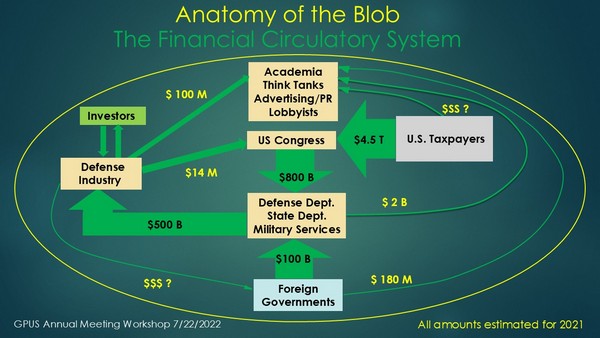
It is not generally understood how few people direct the flow of the hundreds of billions the U.S. spends every year on defense. The senators and representatives on the Armed Services and Appropriations committees of the Congress are easy targets for the lobbyists of the defense corporations. The weapons makers spend about $70 million a year on lobbying in Washington, and they donate generously to members of the key committees that control the defense budget.
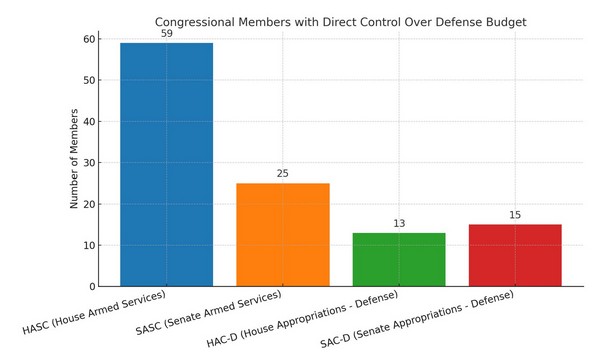
The committee staffers responsible for advising on defense budget items are out-gunned by the industry lobbyists, who earn considerably more, and are proficient in the arts of persuasion. As of 2023 there were 708 active Washington lobbyists working for defense corporations. Most of these lobbyists have gone through the “revolving door” of military or government jobs and are intimately familiar with the political terrain.
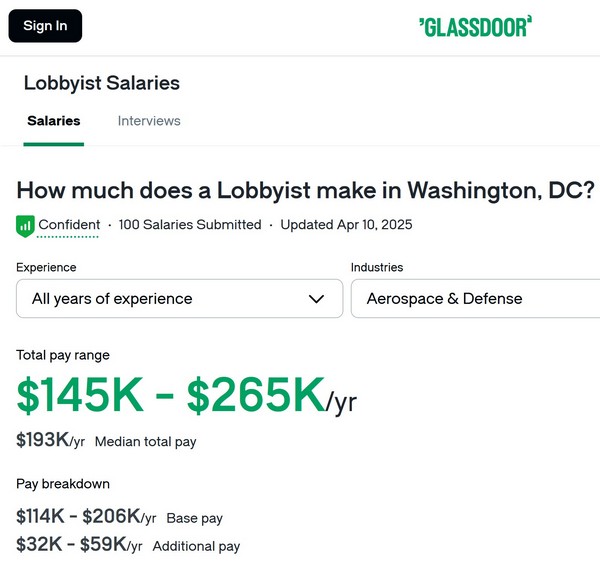
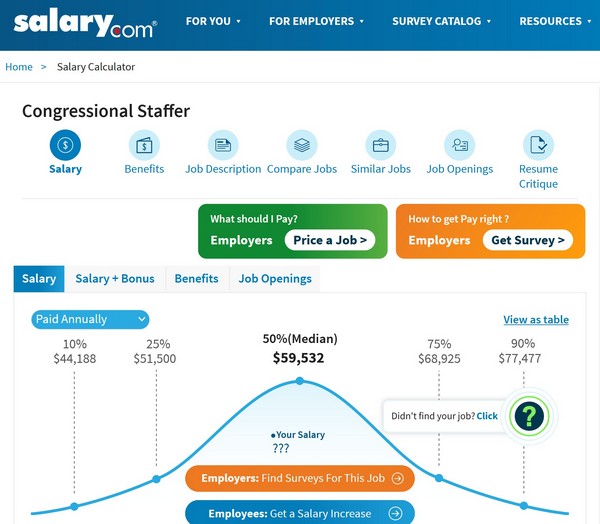
The goals of the lobbyists are two-fold: promote the growth of the overall defense budget and defend the the weapons programs of their employers. There are enormous sums at stake. Although in recent years the U.S. defense budget has consumed about an eighth of the total Federal budget, it has been roughly half of the discretionary budget. The discretionary budget is all outlays that are not legally obligated, and thus directly under congressional control each year.
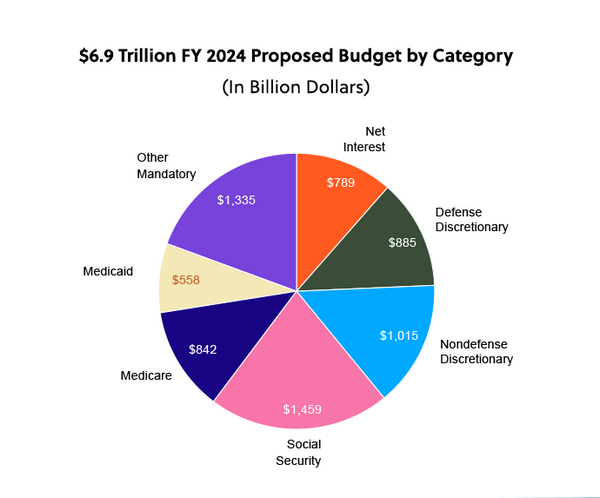
If Trump’s proposed cuts to domestic programs and defense budget increase to $1 trillion are passed, the U.S. will be spending even more of the discretionary budget on weapons and war, pushing the defense share to over 60%.
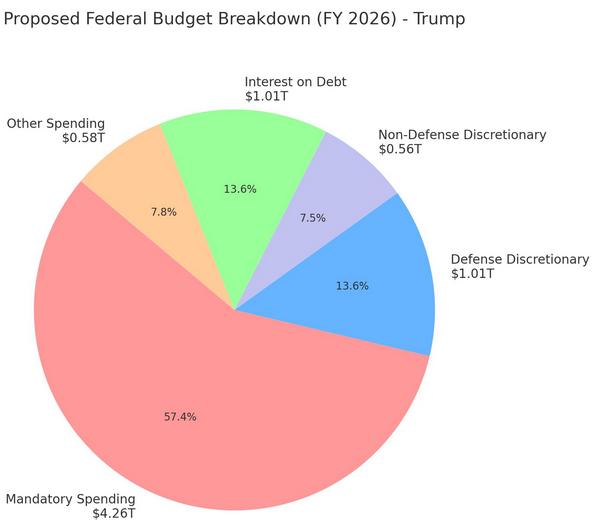
How does the U.S. defense industry run such a successful racket? I have already mentioned their potent lobbying capability. Now let us examine some tools of their trade.
Threat Inflation
A massive defense budget must be justified by threats to the United States. If legitimate threats do not exist, imaginary ones can easily be conjured up. Working with think tanks, media contacts, and bellicose politicians, almost any foreign entity can be puffed up to a serious threat to U.S. “interests” by defense industry lobbyists. At various times, Cuba, Nicaragua, Afghanistan, Iraq, and Libya were considered military threats. For 20 years, Islamic terrorism was the threat justifying huge U.S. military budgets. With the revival of cold war confrontation with Russia and China, we have returned to a tried and true national security threat. The costumes change, but the show goes on.
Gold Plating
It is an article of faith in the U.S. defense community that advanced, highly-complex weaponry can overcome the presumably inferior weaponry of potential adversaries. This bias toward ambitious application of leading-edge technologies is beneficial to arms makers because it raises the costs of weapons programs and justifies delays and difficulties in completing projects. The result is a process of over-specification of weapons designs and disappointing results in the deployed system.
An example of this approach is the M777 howitzer. This field gun was designed to be highly transportable, incorporating titanium parts and other lightweight components. On the battlefield in Ukraine the M777 has suffered from short barrel life, and replacement of barrels and other worn parts has become a logistical problem. The B2 Stealth Bomber, at a cost of $2 billion per aircraft, had the rare distinction of costing more than its weight in gold until 2008. Gold prices have risen since then, but production of the B2 was halted in 2001 and only 20 are operational. Other examples of gold-plated projects are the Gerald Ford aircraft carriers, the Zumwalt destroyer, and the Osprey tilt-rotor transport aircraft.
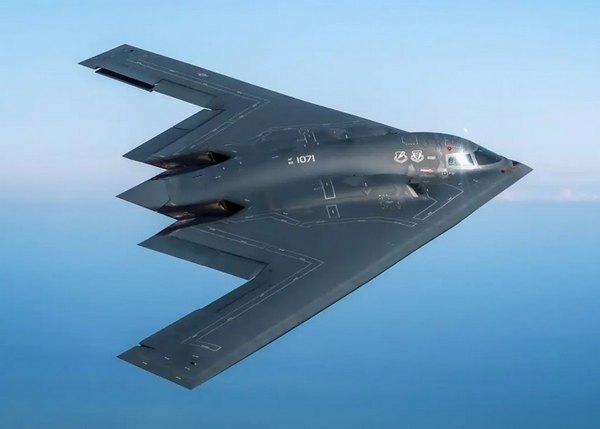
B2 stealth bomber – golden goose?
Non-Competition
The magic of the marketplace has not been working in favor of U.S. taxpayers, as defense corporations have consolidated into five behemoths that manage the biggest weapons projects, such as the F35, nuclear submarines, ICBMs, and the Patriot missile system.
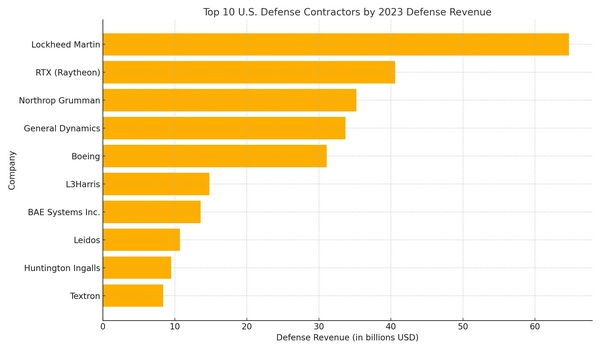
Moreover, some of the contract bidding has become single-source. The $13 billion contract for replacing the U.S. ground launched Minuteman ICBM force was awarded to Northrop Grumman without any competitive bid. What could go wrong?
Deferred Bribery
Dangling the prospect of lucrative future employment is not considered bribery if there is no explicit offer. A senior military officer in the U.S. can retire after 20 years and receive a pension of about 50% of military salary, then take a lobbying job in the defense sector earning double the former military salary. This process is what makes the revolving door spin, and it results in most of Washington defense lobbyists having prior military or government careers. Even retired congressional representatives can cash in on lobbying employment if they have influence with the key funding committees. Thus, decisions on military expenditures are in the hands of people who stand to benefit from actions friendly to potential future employers, and it is all perfectly legal.
Moving Goalposts
When developing complex, highly-sophisticated weapons systems, delays and cost overruns frequently occur. Defense contractors are seldom punished for failures to meet schedule and cost requirements. Instead, project timetables are extended and supplemental funding is awarded. The F35 fighter program has been delayed by more than 8 years and has exceeded original cost expectations by $165 billion.

Lowering the Net
When a big weapons program gets into trouble, performance specifications are sometimes relaxed to allow the program to continue. The F35’s maneuverability, acceleration, and combat radius requirements were all relaxed in the course of the program. A general reduction of weapons testing requirements has also been underway in recent years, much to the liking of the defense contractors.
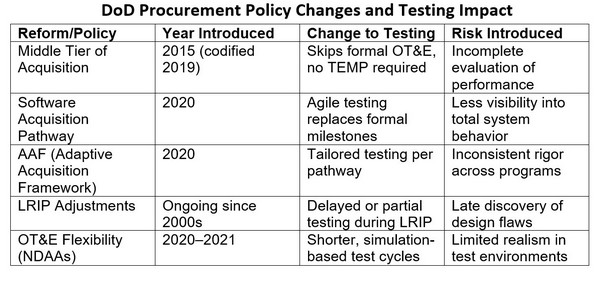
The Secrecy Shield
If no one knows what you are doing, no one knows what you are doing wrong, and this maxim applies to the “black budget” programs of the U.S. Defense Department. Considering the embarrassing failures of defense projects that are publicly accountable, one can only imagine what malfeasance lies behind the cloak of secrecy surrounding programs considered too sensitive for public disclosure. The black budget of undisclosed secret programs has grown to well over $50 billion.
What Can Be Done
Although it is unlikely that the U.S. Congress will resist the lobbying power of the defense industry, there are several measures that should be taken to reduce the abuses of defense racketeering
Debarring is the halting of business eligibility for a contractor for misconduct that has damaged the interests of the government. This can be a ban for a specific interval or a permanent ban. Debarring is a legal sanction that has seldom been used. An increased threat of debarring would result in a diminution of failed deadlines and cost overruns.
Blocking Revolving Doors can easily be effected through legislation increasing the required elapsed time between the end of government service and employment as a lobbyist. Establishing a five or ten year interval would reduce considerably the negative consequences of revolving door hiring.
Defense Department Auditing would improve the oversight of contractor activity and provide valuable management information regarding the life cycle costs of major weapons programs. Unfortunately, the DoD has failed to achieve successful audits. Until the Congress penalizes the armed services for audit failures, this goal will not likely be achieved.
Independent Design and Project Reviews would help avoid many failures of weapons development projects by better evaluating risks. Contractors working in a permissive regulatory environment have perverse incentives to accept program risks when there are no serious consequences for poor performance. Independent reviewers would not be subject to such influences.
Nationalization is the ultimate remedy for defense racketeering. Selective nationalization of projects would be appropriate for the mass production of reliable and effective conventional weapons that are considered relatively unattractive undertakings by defense corporations. By removing misdirected profit incentives and prioritizing on time and under budget project completion, management incentives can be aligned with the interests of U.S. taxpayers, and not those of corporate stockholders.
Conclusion
U.S. defense corporations have succeeded in receiving an enormous portion of the annual discretionary Federal Budget, roughly half a trillion dollars, through legally sanctioned racketeering in the halls of the U.S. Congress. Apart from the diversion of resources from productive domestic uses, the money spent has produced a series of badly flawed weapons projects that have weakened U.S. national security rather than strengthening it. Reforms in this sector are badly needed. These should include measures to curb the political influence of the defense corporations, improve the weapons procurement process, and increase effective oversight of defense projects. Until such reforms are implemented, the naked capitalism of the U.S. defense industry will remain an ugly sight.


I believe you can forget about “debarring” and “independent reviews”.
1) Because the set of main defence contractors has shrunk through acquisitions and fusions, the market is now so concentrated that debarring one of them means simply having no firm able to take over a programme.
Of course, as a compensation one could largely open up the procurement market to foreign firms. However, experience in the past has been that everything will be done to torpedo their entry in the well-protected, cosy US market: see what happened to Airbus vs. Boeing regarding tankers, the French when they managed to get best placed for their field communication equipement RITA, or now the Italians with their frigate (whose design US firms are now thoroughly mucking up because adopting an existing system and just replacing what must absolutely be replaced and only that is a no-no in the USA).
2) Where can “independent reviewers” be found if the market is so concentrated that specialists can only ensure their livelihoods by working at one of the few remaining large contractors (and therefore risk getting blacklisted if their evaluations are “too independent”), or may cause their employer to be blackballed if working at a smaller subcontractor (and thus ultimately losing their job as well in case of an “excessively independent” review)?
Independent reviews should be the realm of DoD civil service…. however, that has impediments of politics and careerism.
In DoD funded development (using R&D appropriation) each milestone reviews engineering tests etc.
The lack of design test of F-35 for example is a failure internal to DoD controls…..
I was a civil servant in Dod acquisition from 1985 to 2019. Last 15 years as a contractor.
Haig writes, “…committees of the Congress are easy targets for the lobbyists of the defense corporations…”
Haig’s diagram with the center box leading with “Academia” reveals much. And thanks NC editors who recently highlighted tech VCs leaning into the defense game.
Just adding this little bit from a piece at Responsible Statecraft re a recent gathering for those persons making bank on tech arms and those in Congress who benefit from “gifts”. Haig’s efficient representation of the game lobby-folk play was on display. See? It’s all about branding and staying on point.
https://responsiblestatecraft.org/artificial-intelligence-2671882925/
“Another founder of a defense technology firm told RS that by lobbying up, Silicon Valley is following in the footsteps of the “game” played by prime contractors like Lockheed Martin and Boeing. “It’s all marketing. It’s about creating a message that sells well…An investigation by the Tech Transparency Project found that Palantir has “hired a slew of well-connected players from Congress and federal agencies, ramped up lobbying activity, and created a foundation to bankroll policy-shaping research, conferences, and public commentary.”
The best chance for congress to control DoD weapons mistakes is the “Beyond Low Rate Production (BLRIP) Report.
It is supposed be be submitted after successful operational tests. No more than 10% of the programmed weapons can be bought before the BLRIP. For F-35 a whole lot more than 10% are delivered and no BLRIP!
Cannot stop the dividends!
How do you do it for an aircraft carrier?
Interesting that AIPAC beats the Defense Industrial Base in bribes by a third.
If I recall correctly, Eisenhower’s original speech used the term Military-Industrial-CONGRESSIONAL-Complex, but “Congressional” was removed. Because reasons.
The purpose of the defense industry’s political, industrial, and military components long ago and far away broke off from the concept of “actual defense” and, instead, just became a money churn to its members, as is well demonstrated by the discussion above.
ETA: Surely the F35 must have passed the “weight in gold” standard by now…..
Probably not, although likely because gold has gotten a lot more exp, too–same as with B2.
Do you know what else passed the “weight in gold” standard long ago? Fort Knox gold.
It has been said that US weapons systems are getting so expensive that by the year 2040 the US military will consist of one tank, one plane and one ship. As for ‘defense corporations have consolidated into five behemoths that manage the biggest weapons projects’ you can thank Bill Clinton for that. Like with media outlets, he put heavy pressure on those defence contractors to amalgamate into many fewer but bigger corporations and I don’t even know why. And now we are seeing the results of all this where if the US had to go up against a peer competitor, that the US military would probably lose. If you don’t believe me, then tell me how the war against Yemen is going. One day the US is going to go into some small country and will have their clock cleaned by what would be considered rat bag forces. On the other hand, numbers and quality for the US army & marines are down low enough that they can no longer easily invade a country like they did twenty years ago. The numbers are not there and that includes the equipment as well and that is why there is no serious talk of landing a force in Yemen for example.
Regarding results in Yemen, where a ceasefire was just announced: Lost around 20 MQ-9 Reapers, had an F-18 either shot down or fall off a carrier, killed a bunch of people with ‘intelligence’ we got off of twitter, had our National Security Advisor disgraced and demoted, and surrendered twice. When it comes to the goal of the operations, to force Anser Allah to quit their sea embargo on Israeli-bound shipping, the military was even less successful, as the embargo has now spread to the air. Trump claims victory, which is his wont, and the mediators from Oman declare the freedom of navigation, but Yemeni officials themselves say only what they’d said before, namely that they will stop attacking U.S. ships if the U.S. stops attacking them, and they will continue to block goods from coming to Israel until the blockade on Gaza is lifted and a ceasefire is declared.
Real nice episode for the U.S. military, about as fine a showing morally as technically and militarily.
As for why no one is thinking of invading Yemen, perhaps Roman history is taught at West Point. Or it could be related to recruitment numbers, as you suggest, or to the fact that Americans of service age are, in the main, unfit for duty even under relaxed late-Iraq war standards. The thinking, then, in the military, with the tasks of war with China set before it, must be either of proxy wars or technological dominance or a combination of the two, but we see how that’s played out in Ukraine.
A thought on military spending: As the rate of profit falls, capital hides in the pork barrels where the competition monster can’t get it,
I believe US Navy has lost one F/A-18F and two F/A-18E Super Hornets during the current “freedom of navigation” operation in the Red Sea. But they did get a couple of farms and a girl school for that.
The statement about one jet shared b all the services was made by Norm Augustine who had been CEO of Lockheed if I recall correctly. I heard him say it in 1992.
The consolidation coincided with the tiny short lived peace dividend when the USSR folded, Clinton happened to be president for most of it and it turned around after 9/11.
US could not do 2003 invasion today!
> US could not do 2003 invasion today!
Again, it seems that the evidence is consistent with the hypothesis that DoD policy (and perhaps US public health policy) is a kind of surreptitious “peace (or at least ‘less war’) though weakness” policy.
Perhaps eventually they will find ways of reorienting the expenditure and effort toward other problems, such as climate disruption.
What you and others are saying is not reflected in the vast majority of movies that one has to scroll through on the streamers. Shall I believe you or my lying eyes?
The outcomes needn’t be intentional. Perhaps they are just bad karma.
The Clinton’s were deep into the pockets of Wall Street and WS loves M&A deals. That would be what I suspect prompted the desire to shrink the field even if the public was sold that it would make for more efficiencies (not).
“One day the US is going to go into some small country and will have their clock cleaned”
I have to say I almost fell over when I read that we only have 20 B-2 bombers!?!? If you shoot down just 2 that’s a 10% loss! And the new B-21’s have barely started to roll off the line and we couldn’t replace either the B-2’s or B-21’s at any high pace if someone could reasonably knock them out of the sky. God forbid we actually find ourselves at war with someone other than a tiny country.
Hell, go look at the munitions our ships carry. We’re not outfitted for a war that lasts more than twenty minutes. And we’d still probably lose that one.
A most wonderful article– well done!
By chance, I was reading another piece immediately prior to this, one written by journalist Thomas Fazi, that is of similar vein (great minds thinking alike, I suppose).
In this story Mr. Hovaness mentions Eisenhower originally intended to describe it as the Military-Industrial-Congressional Complex and Threat Inflation.
To briefly excerpt from Fazi’s work, “…Europe’s continued involvement in the [Ukraine] war ensures its ongoing economic and geopolitical separation from Russia, and reinforces its continued economic dependence on the US — especially in the context of its defence spending hike, much of which would flow to the US military-industrial complex. At the same time, the European representatives of the liberal-globalist establishment would continue to use the Russian threat to entrench their power.”
[Europe’s self-destruction
How should we make sense of Europe’s seemingly self-destructive posture? Four interrelated dimensions can help explain its leaders’ stance: psychological, political, strategic and transatlantic]
https://www.thomasfazi.com/p/europes-self-destruction
Red, meet Pill: together, these two articles alone are enough to crack minds on both sides of the Atlantic.
Thank you for this story.
Don’t find the “what can be done” useful in any way.
Debarring — is a legal process that provides ample opportunity for delay and counter claims, so the question becomes if it is worth the time and effort to pursue.
Blocking revolving doors — I don’t think that many exit to go into high-pay lobby jobs. And the value of former military falls off fast. As it is, I had to sign an exit agreement with staff JAG stating I couldn’t have dealings with certain contractors for a number of years.
Defense Department Auditing — the reason for not getting a clean audit report mainly has to do with how the various financial systems interoperate. Nothing to do with contractor management. That mostly is the purview of DCAA and DCAS. Now I will admit that years ago we had our own Navy offices doing management such as the NAVPRO that transitioned to DoD which I don’t see as an improvement. The Supervisor of Shipbuilding and Repair, USN (SUPSHIP) still exists, but has been highly centralized, in particular on the repair side into the regional maintenance commands.
Independent design and project reviews. OK, exactly who is going to conduct these reviews? DOGE? The only routine “independent review” I have experienced was with Dept of Energy as regards nuclear weapons design. The is also something that is somewhat similar where Dept of Energy reviews Naval Nuclear Power systems. But for other things? Sounds like a money and time sink.
Nationalization — while I can see some benefit in the government recreating a construction capability for both aircraft and ships, that would be alongside existing contractors. On the software side we do plenty of software dev in house; it isn’t clear to me what % would be optimum. In the case of the before mentioned nuclear system the software was developed in gov’t lab, while the independent software nuclear surety analysis was done by a contractor.
A specification not tested is always a pass!
DOGE is staying out of the pentagon.
The audit fails in large part because the DoD has no way to audit much less establish the “value” of its equipment.
That has to do with the fidelity of system specification packages used to certify delivery for payment. The specs are rarely tested to the HW or SW configuration. Mostly they ran out of R&D money and time before the testing was done.
For example an F-35 delivered has baseline specs that were not adequately tested during development. A common issue for decades.
There are other issues such as losing parts and equipment.
The 20 something geeks working for DOGE could see most of this in nanoseconds.
No one ever lost money selling to Uncle Sam!
The most obvious category of remedies does not get much consideration: de-consolidation. Break up the behemoths.
Lobbyists are going to lobby. Attempting to inject idealistic virtue there seems to be foolish game. But, if there were more and rival contractors, lobbyists would oppose other lobbyists as their employers, no longer taking common strategic direction from headquarters, had to lobby against their rivals.
DOD military and civil servants would have to strengthen their capabilities to coordinate, review and manage more numerous and diverse contractors. “Independent review” wouldn’t be a desperate and certainly futile effort to manage a too big to manage contractor, who has already taken over all the functions of oversight that DOD should be handling.
Realistically, what will fix it is that we will end up in a big war and all the expensive trash will be wiped out. And even then I think the hogs will stay at the trough until they are pulled away.
Tariffs make the expensive F-35 even more expensive. This is not Trump’s fault, but rather the fault of U.S. national security policy, which has relied on foreign suppliers for components for weapons designed to defend the United States.
All the money gained from tariffs on F-35 parts will go into buying more F-35s.
The missing aspects in the analysis are
War games, or scenarios of using weapons, manpower etc in response to threats and facing the enemy capabilities and methods. E.g. how airplanes would be used? If the main use is launching projectiles from distance, how important is maneuverability and speed? What specs of mobile artillery actually matter (including tanks). What about assorted alternatives to “classic” ships, planes and tanks.
Other aspect of war games is conflict scenarios and assessment of conflict resolution options. That can be most important, actually. E.g. what would be the cost of resolving issue with Yemen by actually forcing ceasefire in Gaza and occupied territories? And the cost of not resolving the issue? Same can be applied to every “threat” that dominates the current agenda.
Unless independent experts run the gaming simulations, the outcomes cannot be trusted. Currently this gaming is done by the military and contractors beholden to the Blob. Even so, some game results have indicated likely defeats in wars against China or Iran. Perversely, negative outcomes are used as justification for even more military spending.
There’s an episode of War Nerd where they recount an anti-Iran war game and all the ways they had to thumb the scale to keep the red team from laying waste to our boys. IIRC, it got to the point where the Iranians were told that they couldn’t shoot down troop transports while they were in the air, and American ships that had already been sunk were returned to the game.
The sad thing is that this could be an episode from this year or 2017, because total catastrophe is such an attractive nuisance for our thought leaders.
“A massive defense budget must be justified by threats to the United States.”
This is the basic bullshit premise that keeps the wheels of the ‘defense’ industry turning. It seemingly is accepted as gospel, despite the reality that NO ONE is going to launch an attack on our shores. And why would they? If there is any threat, it would be to the imperium.
What is equally mystifying is why our successive administrations fail to see what an economic boom would come from investing in something that might actually benefit society, such as renewable energy. How many solar panels equals a Stealth bomber? The real Stealth is how they made off with the money.
I think we should also always add to the Pentagon budget the legacy costs of our permanent warfare state, that being the Veterans Administration budget which adds roughly another 369 billion dollars annually. In addition, interest costs on our 36 trillion dollar national debt, which Michael Hudson attributes mostly to our permanent wars and maintenance of our empire of overseas military bases, adds another trillion dollars. So we could realistically put the cost of our war and weapons budget at over two trillion a year.